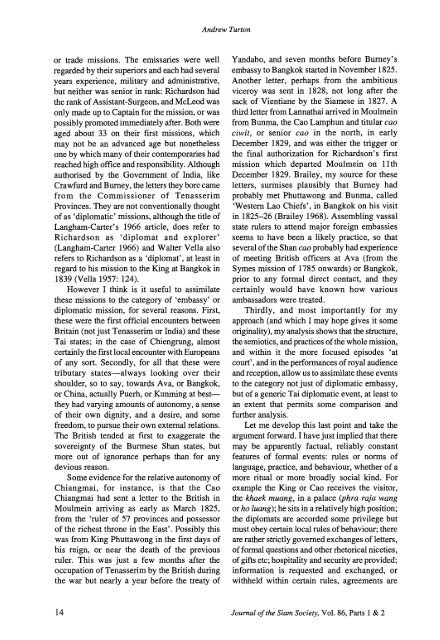The Journal of the Siam Society Vol. LXXXVI, Part 1-2 ... - Khamkoo
The Journal of the Siam Society Vol. LXXXVI, Part 1-2 ... - Khamkoo
The Journal of the Siam Society Vol. LXXXVI, Part 1-2 ... - Khamkoo
Create successful ePaper yourself
Turn your PDF publications into a flip-book with our unique Google optimized e-Paper software.
Andrew Turton<br />
or trade missions. <strong>The</strong> emissaries were well<br />
regarded by <strong>the</strong>ir superiors and each had several<br />
years experience, military and administrative,<br />
but nei<strong>the</strong>r was senior in rank: Richardson had<br />
<strong>the</strong> rank <strong>of</strong> Assistant-Surgeon, and McLeod was<br />
only made up to Captain for <strong>the</strong> mission, or was<br />
possibly promoted immediately after. Both were<br />
aged about 33 on <strong>the</strong>ir first missions, which<br />
may not be an advanced age but none<strong>the</strong>less<br />
one by which many <strong>of</strong> <strong>the</strong>ir contemporaries had<br />
reached high <strong>of</strong>fice and responsibility. Although<br />
authorised by <strong>the</strong> Government <strong>of</strong> India, like<br />
Crawfurd and Burney, <strong>the</strong> letters <strong>the</strong>y bore came<br />
from <strong>the</strong> Commissioner <strong>of</strong> Tenasserim<br />
Provinces. <strong>The</strong>y are not conventionally thought<br />
<strong>of</strong> as 'diplomatic' missions, although <strong>the</strong> title <strong>of</strong><br />
Langham-Carter's 1966 article, does refer to<br />
Richardson as 'diplomat and explorer'<br />
(Langham-Carter 1966) and Walter Vella also<br />
refers to Richardson as a 'diplomat', at least in<br />
regard to his mission to <strong>the</strong> King at Bangkok in<br />
1839 (Vella 1957: 124).<br />
However I think is it useful to assimilate<br />
<strong>the</strong>se missions to <strong>the</strong> category <strong>of</strong> 'embassy' or<br />
diplomatic mission, for several reasons. First,<br />
<strong>the</strong>se were <strong>the</strong> first <strong>of</strong>ficial encounters between<br />
Britain (not just Tenasserim or India) and <strong>the</strong>se<br />
Tai states; in <strong>the</strong> case <strong>of</strong> Chiengrung, almost<br />
certainly <strong>the</strong> first local encounter with Europeans<br />
<strong>of</strong> any sort. Secondly, for all that <strong>the</strong>se were<br />
tributary states-always looking over <strong>the</strong>ir<br />
shoulder, so to say, towards Ava, or Bangkok,<br />
or China, actually Puerh, or Kunming at best<strong>the</strong>y<br />
had varying amounts <strong>of</strong> autonomy, a sense<br />
<strong>of</strong> <strong>the</strong>ir own dignity, and a desire, and some<br />
freedom, to pursue <strong>the</strong>ir own external relations.<br />
<strong>The</strong> British tended at first to exaggerate <strong>the</strong><br />
sovereignty <strong>of</strong> <strong>the</strong> Burmese Shan states, but<br />
more out <strong>of</strong> ignorance perhaps than for any<br />
devious reason.<br />
Some evidence for <strong>the</strong> relative autonomy <strong>of</strong><br />
Chiangmai, for instance, is that <strong>the</strong> Cao<br />
Chiangmai had sent a letter to <strong>the</strong> British in<br />
Moulmein arriving as early as March 1825,<br />
from <strong>the</strong> 'ruler <strong>of</strong> 57 provinces and possessor<br />
<strong>of</strong> <strong>the</strong> richest throne in <strong>the</strong> East'. Possibly this<br />
was from King Phuttawong in <strong>the</strong> first days <strong>of</strong><br />
his reign, or near <strong>the</strong> death <strong>of</strong> <strong>the</strong> previous<br />
ruler. This was just a few months after <strong>the</strong><br />
occupation <strong>of</strong> Tenasserim by <strong>the</strong> British during<br />
<strong>the</strong> war but nearly a year before <strong>the</strong> treaty <strong>of</strong><br />
Yandabo, and seven months before Burney's<br />
embassy to Bangkok started in November 1825.<br />
Ano<strong>the</strong>r letter, perhaps from <strong>the</strong> ambitious<br />
viceroy was sent in 1828, not long after <strong>the</strong><br />
sack <strong>of</strong> Vientiane by <strong>the</strong> <strong>Siam</strong>ese in 1827. A<br />
third letter from Lannathai arrived in Moulmein<br />
from Bunma, <strong>the</strong> Cao Lamphun and titular cao<br />
ciwit, or senior cao in <strong>the</strong> north, in early<br />
December 1829, and was ei<strong>the</strong>r <strong>the</strong> trigger or<br />
<strong>the</strong> final authorization for Richardson's first<br />
mission which departed Moulmein on 11th<br />
December 1829. Brailey, my source for <strong>the</strong>se<br />
letters, surmises plausibly that Burney had<br />
probably met Phuttawong and Bunma, called<br />
'Western Lao Chiefs', in Bangkok on his visit<br />
in 1825-26 (Brailey 1968). Assembling vassal<br />
state rulers to attend major foreign embassies<br />
seems to have been a likely practice, so that<br />
several <strong>of</strong> <strong>the</strong> Shan cao probably had experience<br />
<strong>of</strong> meeting British <strong>of</strong>ficers at Ava (from <strong>the</strong><br />
Symes mission <strong>of</strong> 1785 onwards) or Bangkok,<br />
prior to any formal direct contact, and <strong>the</strong>y<br />
certainly would have known how various<br />
ambassadors were treated.<br />
Thirdly, and most importantly for my<br />
approach (and which I may hope gives it some<br />
originality), my analysis shows that <strong>the</strong> structure,<br />
<strong>the</strong> semiotics, and practices <strong>of</strong> <strong>the</strong> whole mission,<br />
and within it <strong>the</strong> more focused episodes 'at<br />
court', and in <strong>the</strong> performances <strong>of</strong> royal audience<br />
and reception, allow us to assimilate <strong>the</strong>se events<br />
to <strong>the</strong> category not just <strong>of</strong> diplomatic embassy,<br />
but <strong>of</strong> a generic Tai diplomatic event, at least to<br />
an extent that permits some comparison and<br />
fur<strong>the</strong>r analysis.<br />
Let me develop this last point and take <strong>the</strong><br />
argument forward. I have just implied that <strong>the</strong>re<br />
may be apparently factual, reliably constant<br />
features <strong>of</strong> formal events: rules or norms <strong>of</strong><br />
language, practice, and behaviour, whe<strong>the</strong>r <strong>of</strong> a<br />
more ritual or more broadly social kind. For<br />
example <strong>the</strong> King or Cao receives <strong>the</strong> visitor,<br />
<strong>the</strong> khaek muang, in a palace (phra raja wang<br />
or ho luang); he sits in a relatively high position;<br />
<strong>the</strong> diplomats are accorded some privilege but<br />
must obey certain local rules <strong>of</strong> behaviour; <strong>the</strong>re<br />
are ra<strong>the</strong>r strictly governed exchanges <strong>of</strong> letters,<br />
<strong>of</strong> formal questions and o<strong>the</strong>r rhetorical niceties,<br />
<strong>of</strong> gifts etc; hospitality and security are provided;<br />
information is requested and exchanged, or<br />
withheld within certain rules, agreements are<br />
14<br />
<strong>Journal</strong> <strong>of</strong> <strong>the</strong> <strong>Siam</strong> <strong>Society</strong>, <strong>Vol</strong>. 86, <strong>Part</strong>s 1 & 2

















